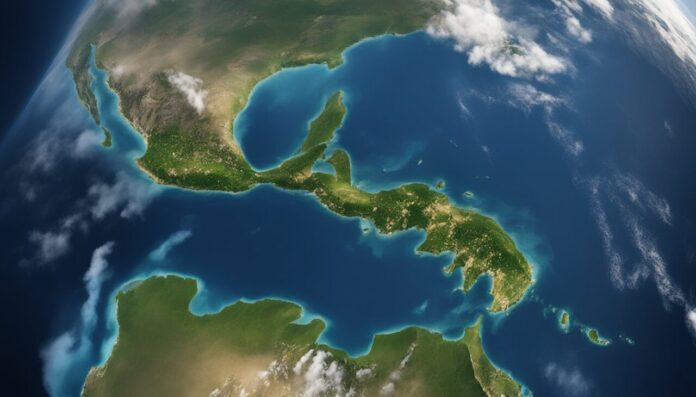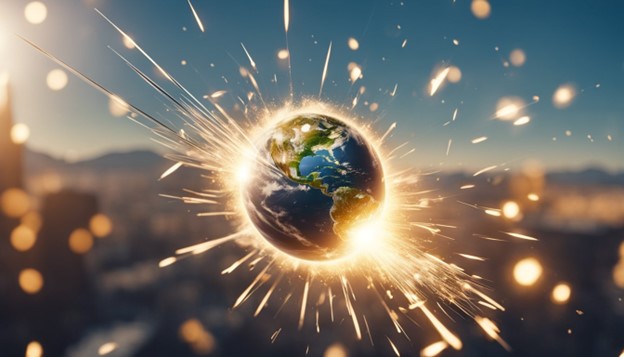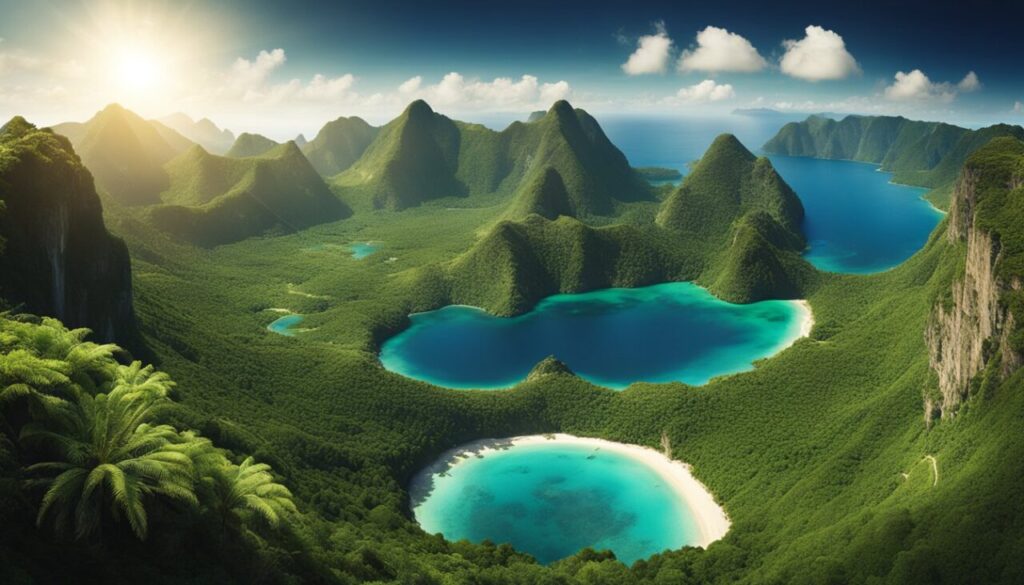
We humans have been on Earth for a mere 300,000 years, while the planet has existed for more than 4.5 billion years. And so, while we’re already customizing the planet to our own needs, the planet will certainly be longer here than we do. Therefore, a curiosity arises within us to predict the future and contemplate what Earth will look like in 1 million years.
Will continents change? Will the climate change? Will we still be here?
Let’s explore these and many other questions about our home planet and its future in this article.
And while it’s impossible to predict the future with certainty, present understanding in various scientific fields allows for the prediction of some far-future events, if only in the broadest outline.
Also, by looking back 1 million years and comparing it with today’s Earth, we can make some perhaps educated guesses about what might happen in the future.
So let’s start.
Related:
Earth in One Million Years?

Geological transformations are one of the main drivers of change on Earth. Over the next million years, tectonic plates will continue to shift and collide, leading to the formation of new mountain ranges and the disappearance of old ones.
Climate evolution will also play a significant role in shaping the future of the planet.
As atmospheric carbon dioxide levels continue to rise, temperatures will increase, leading to more extreme weather events and rising sea levels.
However, temperatures will also decrease during certain periods, and it is likely that there will be several ice ages over the next 1 million years on Earth.
Additionally, biological diversity will continue to decline as human activity invades natural habitats, leading to the extinction of many species.
And finally, astronomical influences, such as the potential asteroid impact(s), will also have a big effect on the planet’s future.
Okay, so with that let’s disseminate each of the beforementioned topics in detail and answer the question from the beginning of this article: “What will Earth look like in 1 million years?”
First, let’s delve into a bit of history. By comparing the Earth’s conditions 1 million years ago to the present, we can gain insights into what might happen in the next million years.
Interesting fact: Due to the gradual deceleration of our planet's rotation, Earth's day lengthens by approximately 1.8 milliseconds every 100 years. This means that in 1 million years, a day will be extended by 18 seconds!
Looking Back 1 Million Years and Comparing it with Today’s Earth

The most important thing to examine is the movement of tectonic plates.
Namely, tectonic plates are large slabs of rock that make up the Earth’s crust. They move around on the molten rock below, driven by the heat generated by the Earth’s core.
Over millions of years, these plates can collide, separate, or slide past each other, causing earthquakes, volcanic eruptions, and the formation of mountains and ocean floors.
On average tectonic plates move at a rate of about 10 centimeters per year.
This might not sound like much, but over millions of years, it can add up to significant changes (100km in 1 million years) in the Earth’s geography.
One million years ago, the continents and islands had a slightly different appearance compared to today.
For instance, Great Britain became an island by 7000 BC due to the flooding of Doggerland.
Before that period, the island (today Britain) was actually a peninsula and it was linked to the European mainland, specifically in what is currently northeastern France.
In addition to the movement of tectonic plates, other factors such as climate change, volcanic activity, and erosion have also contributed to changes in the Earth’s geography over the past million years.
And we can expect similar to happen in the next million years.
So, with that, we need to delve into greater detail and uncover the Earth in 1 million years!
Geological Transformations

Plate Tectonics and Continental Drift
Over the next million years, the movement of tectonic plates will continue to shape the Earth’s surface. Parts of continents will shift and move, with some colliding and others separating.
This movement is known as continental drift and is caused by the convection currents in the Earth’s mantle. The movement of the plates will result in the formation of several new mountain ranges and the disappearance of others.
Volcanic Activity and Island Creation

Volcanic activity will also continue to shape the Earth’s surface over the next million years. New islands will be formed by volcanic eruptions, while others will be eroded by the ocean.
For example, the Hawaiian Islands were formed by volcanic activity over millions of years and so, Earth will witness the formation of some new islands in the future for sure.
But besides island creation, volcanic activity might create enormous problems for Earth in the next million years.
Yes, we’re talking about potential Yellowstone or other supervolcano eruptions.
Interesting fact: Currently there are about 20 known supervolcanoes on Earth.
Potential for Yellowstone Supervolcano Eruption?

There has been much speculation about the potential for a supervolcano eruption at Yellowstone National Park.
While it is impossible to predict with certainty, there is a good chance that Yellowstone will erupt in the next 1 million years. Namely, the Yellowstone supervolcano last erupted around 640,000 years ago
And so, if it were to occur, it would have a significant impact on the Earth’s climate and could potentially cause a mass extinction event.
Note: If you’re interested in the consequences of a potential Yellowstone eruption we invite you to check out our article ‘What Would Happen If Yellowstone Erupted?’
Okay, so besides volcano activity, let’s see potential changes in one million years in other areas.
For example, what will happen with Niagara Falls?
Well…
Niagara Falls might become a giant lake.
Namely, over time, the constant erosion caused by the flow of water over Niagara Falls will probably cause the falls to recede.
Eventually (in around 50,000 years), the falls will disappear altogether eroding its way to Lake Erie which is currently 20 miles (32km) away.
And so, this leads us to the thought of a potential supercontinent in the future.
Possibility for a New Pangea in Million Years?

The continents will probably continue to move and eventually re-form into a new supercontinent similar to Pangea. However, this process will take millions of years to occur and is impossible to predict with certainty.
Specifically, the succeeding supercontinent, known as Pangaea Ultima, is projected to take shape around the equator in approximately 250 million years.
This formation is predicted to happen as the Atlantic Ocean contracts, leading to the collision of a unified Afro-Eurasian continent with the Americas.
In summary, the Earth’s geological transformations over the next million years will be shaped by the movement of tectonic plates, mountain building and erosion, volcanic activity, and the erosion of natural features such as Niagara Falls.
But that’s only one part of the equation. Many other factors will shape the future of Earth.
And one of those is the everchanging climate.
Climate Evolution in 1 Million Years

Global Temperature Changes
Over the past million years, the Earth’s climate has undergone significant changes. The global temperature has fluctuated between glacial and interglacial periods, with ice ages occurring every 100,000 years or so.
During the last ice age, which ended about 12,000 years ago, the global temperature was about 5°C cooler than it is today.
Predicting the exact characteristics and severity of future ice ages is challenging due to the complexity of Earth’s climate system and the various factors influencing it. However, scientists do use models and simulations to make informed predictions about long-term climate trends.
The timing and severity of ice ages are influenced by a combination of factors, including changes in Earth’s orbit, axial tilt, and the concentration of greenhouse gases in the atmosphere.
These factors collectively contribute to variations in solar radiation reaching the Earth’s surface, impacting global temperatures.
While it’s true that some predictions suggest the possibility of the next ice age starting in about 50,000 years, the specifics remain uncertain.
Additionally, human activities, such as the burning of fossil fuels, have introduced a significant amount of greenhouse gases into the atmosphere, which could potentially influence the natural climate cycle.
When a future ice age occurs (and it will), it will likely bring big challenges for human societies. Cooler temperatures, expanding ice sheets, and changes in precipitation patterns will affect agriculture, water resources, and ecosystems.
Looking over the span of a million years, we can be certain that Earth will undergo several ice ages. The severity of these ice ages will vary, with some being more intense than others.
Human civilizations, if they persist over such long time scales, will need to adapt to the changing climate conditions.
And ice ages are not the only things that will happen to Earth in the next million years. Specifically, water levels will also change significantly, and these changes are directly correlated with ice ages.
Water Level Changes

The Earth’s water level has fluctuated over time due to changes in the climate.
Here’s a very brief overview of sea level changes over the past several million years:
- Paleozoic Era (541–252 million years ago): During the early Paleozoic, sea levels were generally higher than today. However, they fluctuated significantly due to tectonic activity, glaciation, and other factors.
- Mesozoic Era (252–66 million years ago): Sea levels remained relatively high during much of the Mesozoic, with some fluctuations. Notably, during the Late Cretaceous, sea levels were high, creating shallow seas in various parts of the world.
- Cenozoic Era (66 million years ago to the present): The Cenozoic has seen a series of ice ages, starting around 34 million years ago. During glacial periods, sea levels dropped as water was stored in continental ice sheets. During interglacial periods, such as the present, sea levels rose again.
So, if history is our teacher, can we predict sea levels in 1 million years?
Well, it depends.
If Earth experiences one of its ice ages in exactly 1 million years, then sea levels will be lower than they are today.
Consequently, if Earth enters a much warmer period in a million years, we can expect that many coastal cities will be submerged.
For instance, sea levels rose to about 30 meters above the present level during a global warm period 3 million years ago.
And so, as we explore geological and climate changes, we also need to look at potential changes in biology in the next 1 million years.
Biological Diversity

Species Evolution & Extinction
Over the course of one million years, it is expected that the Earth’s biological diversity will continue to evolve. Evolution is driven by natural selection, and the process of evolution is usually slow.
However, there are cases where evolution can happen at a much faster rate. For example, when a species is introduced to a new environment, it may have to adapt quickly to survive.
Unfortunately, it is also expected that many species will go extinct in the next one million years.
Interesting fact: Did you know that we are currently in a period called Holocene extinction? The Holocene extinction is a term used to describe the ongoing extinction of species that has been occurring since the end of the last ice age. Many scientists believe that human activity is the primary cause of this extinction. According to a source, only 5% of the world's lands are unaffected by humans, and the remainder of land has a moderate to high degree of modification.
Humans, if alive, will probably undergo the biggest changes concerning behavior, physical looks, and intelligence.
On the other hand, some species will mostly stay the same.
For example, the cockroach species is unlikely to undergo further changes or evolution and is likely to persist in its current form.
But all of those species, including humans, will have to witness different impacts coming from the universe.
Astronomical Influences

Meteorite and Asteroid Impacts
Meteorite impacts are one of the most significant astronomical influences on Earth. Although the probability of a large impact is relatively low, the consequences can be catastrophic.
A large impact can cause widespread destruction, leading to a mass extinction event.
The Chicxulub impact, which occurred 66 million years ago, is believed to have caused the extinction of the dinosaurs.
According to Science.org: “At a basic level, humanity’s survival odds come down to one thing: the chances of a giant space rock slamming into the planet and sending us the way of the dinosaurs.”
Namely, according to a provocative new study, Earth’s recent craters were much larger than previously thought, meaning Earth is more at risk of getting hit hard in the future and especially in next 1 million years.
Science.org article continues by stating:
“Using a new catalog of high-resolution satellite imagery, James Garvin (chief scientist of NASA’s Goddard Space Flight Center) and his colleagues identified large rings around three impact craters and one probable one that are 1 million years old or younger.
To Garvin, the rings imply the craters are tens of kilometers wider, and record far more violent events, than researchers had thought.
If Garvin is right each impact resulted in an explosion some 10 times more violent than the largest nuclear bomb in history, enough to blow part of the planet’s atmosphere into space.
Although not as destructive as the impact that killed off the dinosaurs, the strikes would have perturbed the global climate and caused local extinctions.
Because water and wind quickly erase most impact craters on Earth, researchers estimate impact rates by tallying crater sizes and ages on the Moon. They also study the size of asteroids in orbit near Earth—potential future impactors.
Based on those two methods, researchers estimate that an asteroid or comet 1 kilometer wide or larger hits the planet every 600,000 to 700,000 years.”
And so, if the abovementioned statements are correct, we can expect at least one significant impact in the next million years. This impact could lead to an extinction event affecting humans and all larger animals.
To mitigate the risks of such an event, NASA and other space agencies are monitoring Near-Earth Objects (NEOs) and developing plans to deflect any that pose a threat to Earth. The proposed methods include using kinetic impactors, gravity tractors, and nuclear explosions.
Certainly, assuming we do not destroy ourselves and the planet before, we will likely possess much more advanced technologies in one million years, significantly reducing the chances of a meteorite impact.
This brings us to another significant change that will occur in the next 1 million years—changes in Earth’s atmosphere.
Atmospheric Shifts

Over the next million years, the composition of the Earth’s atmosphere is expected to undergo substantial changes. While the overall balance of gases will remain roughly the same, the relative proportions of different gases will shift.
For example, the concentration of carbon dioxide is likely to increase due to the continued burning of fossil fuels and other human activities. This could lead to an increase in global temperatures and changes in weather patterns.
At the same time, the concentration of oxygen in the atmosphere is likely to decrease slightly. This is due to a number of factors, including the fact that plants will continue to evolve and adapt to changing environmental conditions.
As a result, they may become less efficient at producing oxygen through photosynthesis.
At the same time, we can expect that there will be less phytoplankton in oceans and those small organisms produce 50% of the oxygen we breathe today.
Note: Check out our article “What would happen if phytoplankton went extinct?”
And finally, before reaching a conclusion, we need to delve into one more aspect: changes in Earth’s landscape.
Evolution of Landscapes

Over the course of the next million years, Earth’s landscapes will continue to evolve and change. Some of the major changes that are expected to occur include desertification and forest expansion.
Desertification

Desertification is the process by which fertile land becomes desert, typically as a result of drought, deforestation, or inappropriate agriculture. According to a recent study, the Earth’s landscapes have evolved significantly over the past 100 million years, and this process is expected to continue in the future.
As global temperatures continue to rise, it is likely that many regions of the world will experience more frequent and severe droughts. This will lead to increased desertification, particularly in regions that are already prone to dryness, such as the Sahara Desert and the Middle East.
Forest Expansion

While desertification is expected to occur in many parts of the world, other regions may experience increased forest expansion. According to a new unified theory, the evolution of landscapes has driven the evolution of life on Earth, and this is likely to continue in the future.
As plants slowly expand across the land, the planet ends up hosting varied environments and habitats with favorable conditions for plant evolution, such as the emergence of flowering plants. With time, this leads to the expansion of forests and the growth of new ecosystems.
Overall, the evolution of landscapes will continue to shape the planet in the coming million years, with desertification and forest expansion being two major processes that will likely occur.
Conclusion

In conclusion, the Earth will undergo significant changes over the next 1 million years. The planet will continue to experience various natural phenomena such as volcanic eruptions, earthquakes, and asteroid impacts.
However, humans will also play a major role in shaping the planet’s future through their activities such as deforestation, pollution, and climate change.
While the future of the Earth is uncertain, it is clear that humans have the power to shape its destiny.
Having said that, one thing remains ambiguous, and that one thing can change the whole course of the future in the next 1 million years.
That one thing is – humanity as a whole.
It is not certain at all that we as a species will be still on Earth in the next 1 million years.
Perhaps we will destroy ourselves together with every living species on Earth.
Perhaps we will destroy the whole planet.
Perhaps we will become a Kardashev Scale Type III civilization and we’ll harness the energy of the whole galaxy and we’ll be capable of intergalactic travel.
And finally, perhaps we will be forced to move to another planet because our planet will become uninhabitable in the distant future.
No one can predict the future. Especially such a distant future but it is always worthwhile to be curious and to wonder about the future of humanity and the future of our home planet.
One thing is certain – 1 million years is rather small amount of time for the planet.
Basically, it represents only 0.02222222% of the Earth’s overall current life of 4.5 billion years.
In analogy with human life, with a duration of, say, 80 years, 0.02% would represent only 6 days.
While not much can happen in 6 days for an average human, there could be some challenges, disturbances, sickness, and of course – in 6 days you could die but chances for that are low.
The same goes for Earth. Small changes (on Earth scale) will happen, but it is unlikely that Earth will die out or that something extreme will happen in the sense of the planet’s longevity.
The planet will become “sick” for some period, and it will get some different “wrinkles” but on such a large scale it will look mostly the same as it does today.
Note: If you enjoyed this article you might also like:




















